Recycling PE/PP Plastic Film: A Comprehensive Guide
Recycling PE/PP plastic film az újrahasznosítható gazdaság modern alapköve, mégis különleges működési kihívásokat jelent. A polietilén (PE) és a polipropilén (PP) filmek mindenütt jelen vannak csomagolásban és ipari alkalmazásokban, de könnyűsége és nagy mennyiségük miatt nehézke a hulladékként való kezelése. Egy hatékony ipari újrahasznosítási folyamat elengedhetetlen a problémás hulladékáram átalakításához értékes alapanyaggá, csökkentve a szeméttelepek terhét és megóvva a természeti erőforrásokat. Ez az útmutató részletesen ismerteti a sikeres filmújrahasznosítási működés szükséges lépéseit, berendezéseit és figyelembe veendő tényezőit.
The Material Understanding: PE and PP Films
A PE és PP filmek hőre lágyuló polimerek, amelyek rugalmassága, nedvességállósága és tartóssága miatt értékesek. Ezek mindenütt megtalálhatók, a bevásárló táskák és csökkentett méretű csomagolófólia (LDPE)tól kezdve az agrár filmekig (LLDPE) és a tartós szövetes táskákig (PP). Bár ezek a tulajdonságok használat közben előnyösek, az is igaz, hogy ezek a anyagok évtizedekig fennmaradnak az környezetben.
Az Egyesült Államok Környezetvédelmi Intézete (EPA) szerint a műanyagok egyre nagyobb arányt tesznek ki a városi szilárd hulladékban. Az ipari újrahasznosítás az egyetlen fenntartható út ezen anyag kezelésére. A cél nem csupán a film elhelyezése, hanem magas minőségű, egyenletes újrahasznosított granulátumok előállítása, amelyek versenyképesek a szennyezőanyagokkal.
Az ipari PE/PP filmújrahasznosítási folyamat: lépésről lépésre
Egy sikeres műanyagfilm újrahasznosítási működés több szakaszból áll, ahol minden egyes lépés közvetlenül befolyásolja a végső termék minőségét. Bármelyik szakasz kihagyása vagy rossz végrehajtása kontaminált, alacsony értékű kimenetet eredményez.
1. lépés: Gyűjtés és válogatás
A folyamat a nyersanyag beszerzéssel kezdődik. Ez az anyag lehet poszt-fogyasztói Például: üzleti visszavételből gyűjtve) vagy ipari Például: gyárscráp). A szortírozás kritikus. Az anyagokat polimer típus szerint (PE vs. PP), szín és szennyezettség szintjének megfelelően kell elkülöníteni.
2. lépés: Darabolás és Méretcsökkentés
Nagy film tömbök egy ipari daraboló vagy granulátorba kerülnek. Ez a gép a nagy filmet kisebb, egységes lapokká vágtatja (általában 1-2 hüvelyk méretűre), így az anyag könnyebben tisztítható és szárítható.
3. lépés: Magas friccióval történő mosás és tisztítás
A darabolott film lapok egy mosóvonalon keresztül mennek, hogy eltávolítsák a porosodást, címkéket és ételmaradékokat. Gyakran egy “úszó-süllyedő” tartályt használnak a nehezebb szennyeződésektől a könnyebb PE/PP lapok szétválasztására.
4. lépés: Szárítás és Szárítás
A nedvesség a minőségi granulátum előállításának ellensége. A film lapok mechanikusan szárítókészülékkel történő szárítás után egy hőszárító rendszeren keresztül haladnak, hogy a nedvesség tartalma alacsonyabb legyen, mint 1%.
5. lépés: Granulálás (extrudálás, szűrés és vágás)
Tiszta, száraz lapok kerülnek a granulálási extrúderbe, ahol megolvadnak, homogenizálódnak és szűrődnek. A lágyított műanyagot ezután kisebb, egységes granulátumokká vágják – ez a végső, piacképes termék.
Kritikus berendezések a sikeres filmgyűjtési vonalhoz
Magas minőségű kimenet elérése érdekében egy olyan gépsort kell használni, amely együttműködik. Egy integrált rendszer nem egyetlen berendezés, hanem egy teljes, az Ön specifikus alapanyagához szabott vonal. A főbb komponensek egy nehézgépszerkezetű daráló, egy hatékony mosórendszer, magas teljesítményű szárító és egy szellőztetett extrúder. műanyag fólia újrahasznosító gép Kiemelt megoldás: Egyetlen filmgyűjtési vonal.

Rendszerünk integrálja a darabolást, mosást és granulálást, hogy a szennyezett PE/PP filmet magas értékű, piacképes granulátumokká alakítsa, minimalizálva a munkaerő igényét.
Nézze meg a rendszer részleteit.
A filmgyűjtés legfontosabb kihívásainak leküzdéseAz PE és PP filmek újrahasznosítása számos gyakori akadályt jelent, amelyek speciális technológiai megoldásokat igényelnek:
Anyag szennyeződése:
- Material Contamination: Súlyos szennyezés és nem műanyag anyagok károsíthatják az eszközöket. Erős, többfázisú mosórendszer a megoldás.
- Nyomófestékek és ragasztóanyagok: Ezek befolyásolhatják a visszanyert granulátum minőségét. A gázkibocsátó (ventált) extruderek segítenek eltávolítani a melegedett nyomófestékek által keletkező gázokat.
- Vízszint tartalom: Akár kisebb mennyiségű víz is gyenge, használatlan granulátumokat hozhat létre. Mechanikai és hőszárítás kombinációja elengedhetetlen.
Az értékesítési javaslat: Környezeti és gazdasági megtakarítások
Egy magas minőségű műanyagfilmes hulladék visszanyerő sorozat befektetése erős megtérülést biztosít. Környezetvédelmi szempontból jelentős mennyiségű hulladék kerül elkerülésre a szeméttelepekről, és csökkenti a műanyaggyártás szénlábnyomát. Gazdasági szempontból a alacsony költségű hulladékanyagot magas keresletű áruvá alakítja, és jövedelmező üzleti lehetőséget teremt a visszanyerő üzemek számára.
Gyakran Ismételt Kérdések (GYIK)
Legjobb, ha szétválasztják őket. Az különböző osztályok különböző olvadáspontokkal és tulajdonságokkal rendelkeznek. Polimer típus és szín szerinti szortírozás sokkal értékesebb végterméket eredményez.
A tisztább, annál jobb. Bár egy ipari mosóvonal jelentős szennyeződést képes kezelni, a cél az, hogy minden porozó és nem műanyag szennyeződést eltávolítsunk, mielőtt az extruderbe kerülne.
Széles körű alkalmazásokkal rendelkeznek, beleértve az új műanyag zacskók, kompozit fa, csövek, dobozok és paletták előállítását. A granulátum minősége meghatározza a végső piacot.
Műanyagfilmes hulladék értékesítése
Energycle Machine által gyártott jól tervezett újrahasznosítási vonal okos befektetés egy fenntartható és jövedelmező jövőbe. Szakértőink készen állnak arra, hogy segítsenek az igényeinek elemzésében és a tökéletes megoldás beállításában.
Kérjen árajánlatot a projektjéhez


